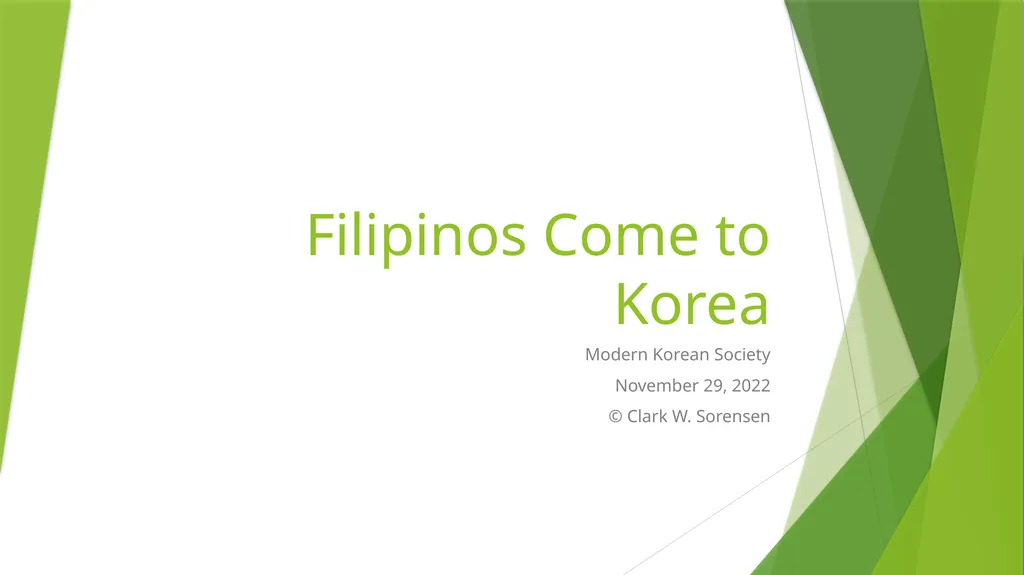Filipinos Come to Korea Modern Korean Society
Author : debby-jeon | Published Date : 2025-11-07
Description: Filipinos Come to Korea Modern Korean Society November 29 2022 Clark W Sorensen Why Filipinos Migrate During the Marcos regime 19611986 martial law 19721981 the Philippines economy stagnated Good English language education While
Presentation Embed Code
Download Presentation
Download
Presentation The PPT/PDF document
"Filipinos Come to Korea Modern Korean Society" is the property of its rightful owner.
Permission is granted to download and print the materials on this website for personal, non-commercial use only,
and to display it on your personal computer provided you do not modify the materials and that you retain all
copyright notices contained in the materials. By downloading content from our website, you accept the terms of
this agreement.
Transcript:Filipinos Come to Korea Modern Korean Society:
Filipinos Come to Korea Modern Korean Society November 29, 2022 © Clark W. Sorensen Why Filipinos Migrate During the Marcos regime 1961-1986 (martial law 1972-1981) the Philippines’ economy stagnated Good English language education While there was economic growth at times, it was unequally distributed and during the 1980s the Philippines began to stagnate Much corruption (Marco regime often called a “kleptocracy” and “crony capitalism”) Per capita income no more than a tenth of the rapidly industrializing East Asian countries like Japan, South Korea, Taiwan, Hong Kong, and Singapore By the 1970s the Philippines had developed a “culture of migration” through which migrants support their families in the Philippines through remittances Philippines Net Migration Rate 2001-2020 (in-migration minus out-migration) Filipinos Abroad 1. USA (immigrants) 4 million (including mixed heritage) 2. Saudi Arabia 1 mil (labor migrants, both skilled and semiskilled) 3. United Arab Emirates 700,000 (labor migrants) 4. Japan 325,000 (72% women who came as entertainers, and about half have permanent residence because they married Japanese) 9. Singapore 200,000 (60% professional and skilled workers, the rest domestic workers) 11. Hong Kong 186,000 (mostly female domestic workers) 15. Taiwan 80,000 (mostly factory workers, with some female marriage migrants) 16. South Korea 50,0000 (mostly factory workers, many illegal, with some female marriage migrants) Things to Notice Filipino migration began to decline after 2010 when the economy began to take off Filipino migration to different countries is not the same Questions to ask: Can Filipino migrants establish permanent residence in their country of migration? Can Filipino migrants bring their families with them? Is there gender balance in the migration to these countries? What kinds of jobs are available in which countries, and who takes them? Professional jobs (US, Saudi Arabia, Singapore) Construction (Saudi Arabia, UAE) Factory jobs (US, Taiwan, South Korea) Domestic Labor (UAE, Singapore, Hong Kong) A Study in Contrasts United States Filipinos can enter as immigrants eligible for permanent residence (Green Card), and can acquire citizenship (many Filipinos have citizenship) Visas are limited and difficult to get, however, so that it tends to be the better off and better educated Filipinos who can get a visa for the USA Some Filipinas marry US soldiers and can immigrate that way, and later bring family members through “family unification” visas (limited by President Trump) (Canada has a “live-in caregiver program”) Hong Kong Most migrants are Filipinas migrating as domestic help (cooking, cleaning, childcare), and













